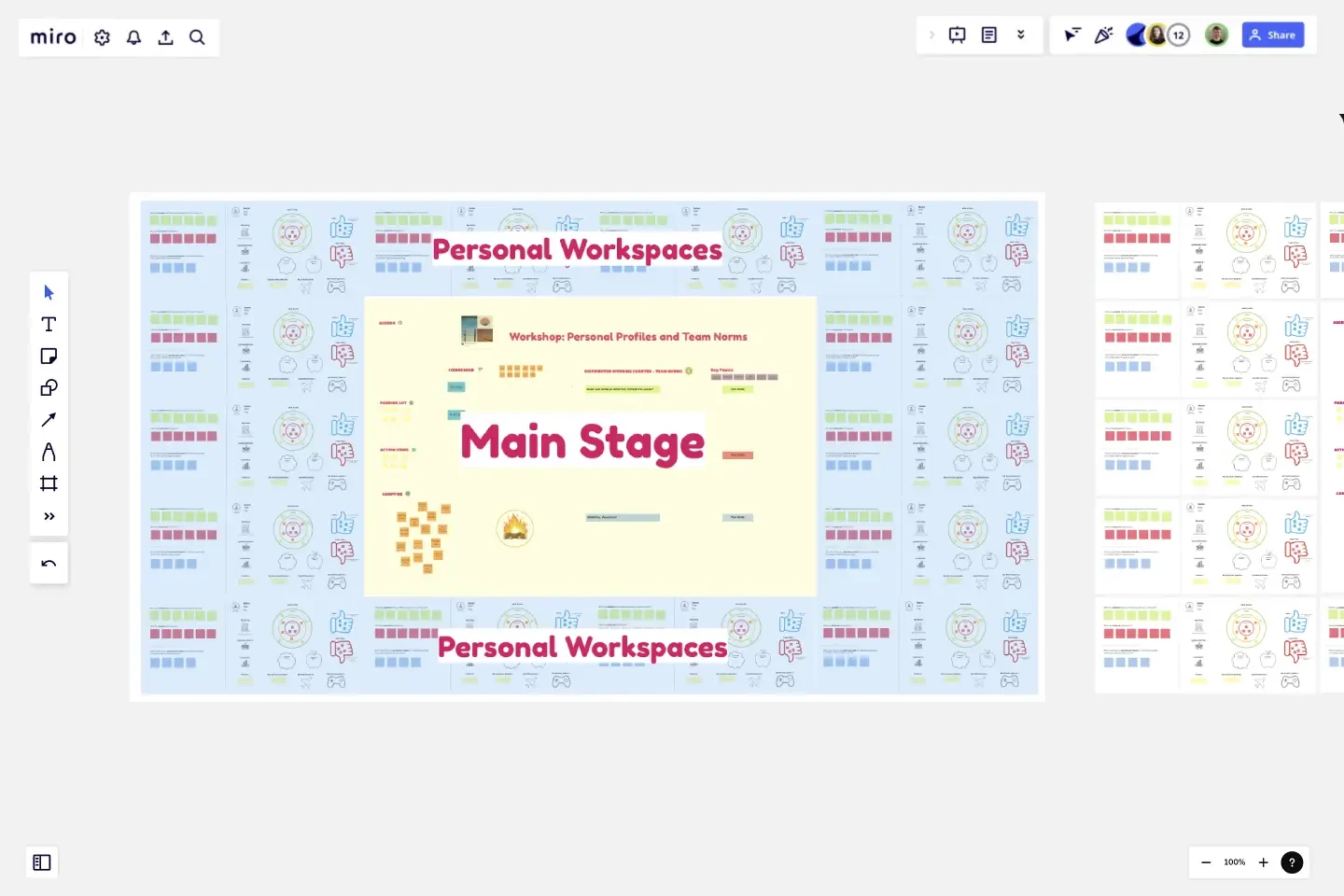Team Norms + Personal Profiles
By structuring the board with Personal Workspaces around a Main Stage, you can give your team space to create their profiles and brainstorm norms.
By structuring the board with Personal Workspaces around a Main Stage, you can give your team space to create their profiles and brainstorm norms.
How to use Team Norms + Personal Profiles
Step 1: Reflect individually on working in distributed teams.
What we did: I asked each person to write on sticky notes all of the practices that have enabled effective distributed work and those that have hindered it. Next I asked the team to identify the essential principles they felt critical when working on a distributed team.
Step 2: Group and vote on principles.
What we did: The team moved their stickies up to the main stage and began to organize them into themes. I had the group vote on the practices and principles that resonated with them the most. We then organized the top voted ones and had an open discussion about each one. Organize and discuss the top voted stickies. I asked different members of the team what each means to them? It’s also important to clarify any inconsistencies in understanding.
Step 3: Wrap up and next steps.
What we did: One of our team members volunteered to take the lead on drafting a polished version of the team’s norms. She drafted a working document and shared with the broader team for feedback and validation. The team plans to review it on a regular cadence, as norms will naturally evolve.
The Outcomes
After a one-hour guided session, we were able to create an agreed upon set of norms that the team can always refer back to and tweak if the team’s way of working evolves. The document covers everything from calendaring practices to hours of operation to meeting rituals.
Get started with this template right now.
Online Sketching Template
Works best for:
UX Design, Desk Research, Design Thinking
Before you go full steam ahead with a promising idea, look at it from a high level — to know how it functions and how well it meets your goals. That’s what sketches do. This template gives you a powerful remote collaboration tool for the initial stages of prototyping, whether you’re sketching out web pages and mobile apps, designing logos, or planning events. Then you can easily share your sketch with your team, and save each stage of your sketch before changing it and building on it.
3-Circle Venn Diagram
Works best for:
Education, Diagrams, Brainstorming
Venn diagrams have been a staple of business meetings and presentations since the 1800s, and there’s a good reason why. Venn diagrams provide a clear, effective way to visually showcase relationships between datasets. They serve as a helpful visual aid in brainstorming sessions, meetings, and presentations. You start by drawing a circle containing one concept, and then draw an overlapping circle containing another concept. In the space where the circles overlap, you can make note of the concepts’ similarities. In the space where they do not, you can make note of their differences.
Meeting Reflection Template
Works best for:
Meetings, Brainstorming, Team Meetings
When schedules get hectic, “learning by doing” becomes the default way to learn. So make time for your team to learn in other valuable ways — by reflecting and listening. Led by “learners,” (team members who share with the rest of the team), a meeting reflection lets teammates share new information about a client’s business or an internal business initiative, offer problem-solving techniques, or even recommend books or podcasts worth checking out. Meeting reflections also encourage colleagues at all levels to engage in each other’s professional development of their teammates.
Mood Board Template
Works best for:
Design, Brainstorming, Ideation
When you’re kicking off a creative project, it’s sometimes important to communicate the mood you’re trying to evoke — but it’s so hard to do it with words. So create a mood board and use images, color palettes, textures, and typography. Mood boards are also perfect for gathering inspiration and sketching out and pitching ideas, and they’re not just for designers — your content writers, sales teams, and product teams can use them too, and this template makes it easy for all of you to get started.
PESTLE Analysis Template
Works best for:
Ideation, Strategic Planning, Business Management
Want to keep your company secure and performing soundly? You have to first know how you’ll be affected by outside elements and factors — especially those that are political, economic, social, technological, legal and environmental in nature. A PESTLE Analysis helps you identify them and prepare for them. With this easy-to-use template, you can conduct a PESTLE Analysis, then use the results to shape your strategic planning, budget allocation, marketing, product updates, and organizational change initiatives.
Pros and Cons List Template
Works best for:
Decision Making, Documentation, Strategic Planning
A pros and cons list is a simple but powerful decision-making tool used to help understand both sides of an argument. Pros are listed as arguments in favor of making a particular decision or action. Cons are listed arguments against it. By creating a list that details both sides of the argument, it becomes easier to visualize the potential impact of your decision. To make your pros and cons list even more objective, it can help to weight each pro and con against the others. You can then present your decision with confidence, making a strong argument for why it’s the right one.
